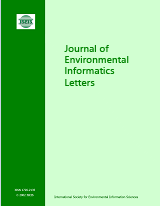Vol 11, Issue 2 (June 2024)
| Exploring the Role of Airtightness for Achieving Carbon Neutrality in Canadian Residential Buildings: A Streamlined Life Cycle Assessment |
PDF
|
| J. J. Gu, X. Y. Xin, Q. Zhang, X. L. Wu | 61-68 |
| Removal of Fluoride from Drinking Water by Utilizing Modified Bagasse Sugarcane as Low-Cost Adsorbents for Bilaspur City, Chhattisgarh |
PDF
SUPPLEMENTARY MATERIAL
|
| D. Verma, J. Supe, S. Verma, R. R. Singh | 69-81 |
| Modelling Impact of Land Use Changes and Climate on Soil Erosion in the Uma Oya River Basin, Sri Lanka |
PDF
SUPPLEMENTARY MATERIAL
|
| C. Jayasuriya, C. Palliyaguru, V. Basnayake, R. K. Makumbura, M. B. Gunathilake, U. Rathnayake | 82-92 |
| Assessment of Reservoir Sedimentation Using Geospatial Tools: A Case Study of Kadana Reservoir |
PDF
SUPPLEMENTARY MATERIAL
|
| S. Jha, S. Dixit, D. Mehta, S. Verma, M. M. Shaikh, P. Patel | 93-100 |
| Rainfall Intensity-Duration-Frequency Relationships: A Robust Foundation for Urban Decision-Making and Flood Management: A Case Study |
PDF
SUPPLEMENTARY MATERIAL
|
| D. Baudhanwala, D. Mehta, S. Zoysa, U. Rathnayake | 101-108 |
| Enhancing Model Calibration and Uncertainty Estimation through Multi-Objective Optimization with SUFI-2 Algorithm |
PDF
|
| A. K. Shukla, I. Ahmad, M. K. Verma, S. K. Jain | 109-122 |
Aims and Scope
Journal of Environmental Informatics Letters (JEIL) is an international, peer-reviewed, and interdisciplinary publication designed to foster research innovation and discovery on basic science and information technology for addressing various environmental problems. The journal aims to motivate and enhance the integration of science and technology to help develop sustainable solutions that are consensus-oriented, risk-informed, scientifically-based and cost-effective. JEIL serves researchers, educators and practitioners who are interested in theoretical and/or applied aspects of environmental science, regardless of disciplinary boundaries. The topics addressed by the journal include:
- Planning of energy, environmental and ecological management systems
- Simulation, optimization and Environmental decision support
- Environmental geomatics - GIS, RS and other spatial information technologies
- Informatics for environmental chemistry and biochemistry
- Environmental applications of functional materials
- Environmental phenomena at atomic, molecular and macromolecular scales
- Modeling of chemical, biological and environmental processes
- Modeling of biotechnological systems for enhanced pollution mitigation
- Computer graphics and visualization for environmental decision support
- Artificial intelligence and expert systems for environmental applications
- Environmental statistics and risk analysis
- Climate modeling, downscaling, impact assessment, and adaptation planning
- Other areas of environmental systems science and information technology
© 2024 ISEIS - International Society for Environmental Information Sciences
